ホーム > 市政 > 市の概要 > IYO CITY Information > Visit
ここから本文です。
掲載日:2012年4月18日
Visit
Goshikihama Seaside Park
This is Iyo City's most central beach location and is within twenty minutes walk of JR Iyo-shi train station. The beach has beautiful white sand and palm tree. The view island is of steep-sided mountains, while offshore there are the shapes of the islands of the inland sea. It is a beautiful place to relax and is well-catered for, with changing rooms and a shop selling snacks and drinks (only open in the summer).
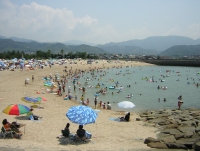
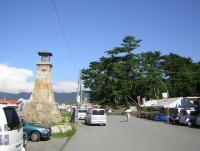 Within close proximity to Goshikihama Beach, between the beach and Gunchuu harbour, are also some of the city's histrical sights. there is a lighthouse which is one of the symbols of Iyo City and was constructed in the 1870s. Not far from this is the Saihinkan meeting house which is famous for having been visited by Russian Prisoners of war during the Russo-Japanese War (1904-5), and prestigiously, the first prime minister of Japan, Itou Hirobumi, in 1909.
Within close proximity to Goshikihama Beach, between the beach and Gunchuu harbour, are also some of the city's histrical sights. there is a lighthouse which is one of the symbols of Iyo City and was constructed in the 1870s. Not far from this is the Saihinkan meeting house which is famous for having been visited by Russian Prisoners of war during the Russo-Japanese War (1904-5), and prestigiously, the first prime minister of Japan, Itou Hirobumi, in 1909.
Eiyouji Temple
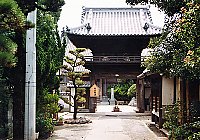 The gates of this temple were constructed during the Edo period and are covered with beautiful carvings of turtles and cranes. There are several graves of importance within the grounds of this temple including those of some of the members of the Miyauchi family (founders of Iyo City), the haiku poet Nakata Ryuuen and Takechi Goyuu (calligraphy teacher of Masaoka Shiki, who was the creater of the modern form of haiku).
The gates of this temple were constructed during the Edo period and are covered with beautiful carvings of turtles and cranes. There are several graves of importance within the grounds of this temple including those of some of the members of the Miyauchi family (founders of Iyo City), the haiku poet Nakata Ryuuen and Takechi Goyuu (calligraphy teacher of Masaoka Shiki, who was the creater of the modern form of haiku).
Zoufukuji Temple
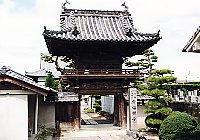 This Zen temple with a multi-storey gate is significant for being the family temple of the provincial governor and many local officials during feudal times. Many of these officials are buried within the grounds. A stone memorial within the temple grounds commemorates the visit of a Dutch doctor to the area in 1853.
This Zen temple with a multi-storey gate is significant for being the family temple of the provincial governor and many local officials during feudal times. Many of these officials are buried within the grounds. A stone memorial within the temple grounds commemorates the visit of a Dutch doctor to the area in 1853.
Miyauchi Kosaburou's Residence
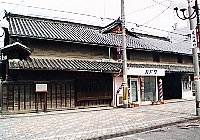 This is the old residence of one of the founders of Iyo City. It is a large retirement villa with a 265 years old roof and a tea house within its grounds. It is notable for its unique use of short pillars and for having been designed by the same person responsible for Oozu City's Garyuu Sansou Villa.
This is the old residence of one of the founders of Iyo City. It is a large retirement villa with a 265 years old roof and a tea house within its grounds. It is notable for its unique use of short pillars and for having been designed by the same person responsible for Oozu City's Garyuu Sansou Villa.
Iyogaoka Hachiman Shrine
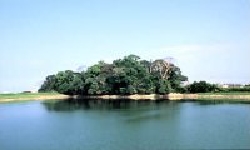
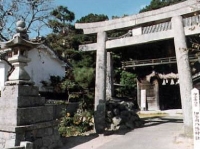 This shrine enshrines the deities of Empress Chuai, Empress Jinguu and Emperor Oujin. It was revered as a place of prayer used by the Katou fumily, the head family of the Oozu clam. The shrine is also surrounded by some of the largest burials mounds in Ehime prefecture. These are thought to contain the remains of members of a powerful clan, whose bodies were interred here between 500 and 600AD, and are registered as Prefecture Designated Cultural Properties.
This shrine enshrines the deities of Empress Chuai, Empress Jinguu and Emperor Oujin. It was revered as a place of prayer used by the Katou fumily, the head family of the Oozu clam. The shrine is also surrounded by some of the largest burials mounds in Ehime prefecture. These are thought to contain the remains of members of a powerful clan, whose bodies were interred here between 500 and 600AD, and are registered as Prefecture Designated Cultural Properties.
In more recent times, in 1906, the shrine received the donation of a large votive tablet which was given as a gift by a group of veterans of the Russo-Japanese War (1904-5).
The tablet display a scene from the war, with the depiction of a Russian soldier being saved by a member of the Japanese army medical core. This tablet has created an important link between Iyo City and Russia. There is a full-scale replica of this tablet in the Ehime Museum of Histry in Seiyo City.
Syoumyouji Temple
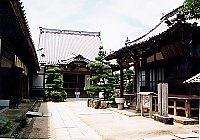 This temple was built in the 12th century and is of the Shingon Buddhist sect. Behind the temple is a walking route which takes you round "a circuit of the 88 sacred locations of Shoumyouji Temple" (the member being a play on the number of temples on the famous Shikoku temple circuit).
This temple was built in the 12th century and is of the Shingon Buddhist sect. Behind the temple is a walking route which takes you round "a circuit of the 88 sacred locations of Shoumyouji Temple" (the member being a play on the number of temples on the famous Shikoku temple circuit).
Kamakura Shrine
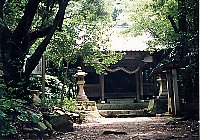 This is a small shrine which is known as "Kamakura-san" and enshrines a member of the Genji clan, Minamoto no Noriyuki. Natsume Souseki and Masaoka Shiki visited and composed poetry here.
This is a small shrine which is known as "Kamakura-san" and enshrines a member of the Genji clan, Minamoto no Noriyuki. Natsume Souseki and Masaoka Shiki visited and composed poetry here.
Shiosai Seaside Park
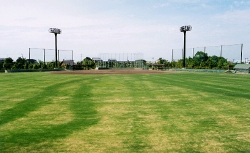
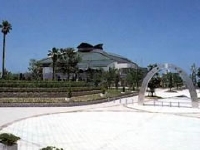 The sporting facilities at Shiosai Seaside Park are in an ideal seafront location. There is a weights room, running track, basketball courts, tennis courts, a football (soccer) pitch and a baseball field. In 2006, Shiosai hosted an "Olympic Day Run" event in which there was a fun led by several Japanese Olympic athletes.
The sporting facilities at Shiosai Seaside Park are in an ideal seafront location. There is a weights room, running track, basketball courts, tennis courts, a football (soccer) pitch and a baseball field. In 2006, Shiosai hosted an "Olympic Day Run" event in which there was a fun led by several Japanese Olympic athletes.
Iyo Inari Shrine
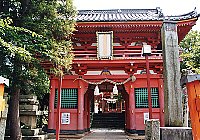
A tree with on age From ancient times - Now the buds sprout. (Monta Kazuki)
This shrine is well worth a visit as it has several interesting historical and cultural features. The shrine was given a title by the imperial family in 1802 and the large, red Yagura Gate, just beyond the torii, is a Prefecture Designated Cultural Property. Construction of this detached gate was completed in 1662 and it combines the best of Tang and Japanese architectural styles. It was disigned by the famous carpenter Saemon, designer of Isaniwa Shrine (Matsuyama), a National Important Cultural Property.
A nearby wisteria trellis supports white and purple wisteria which were originally brought to the city from Kyoto in the eighteenth century. The annual blooming of these plants is commemorated in a haiku on a plaque just below the plant:
Fusouboku
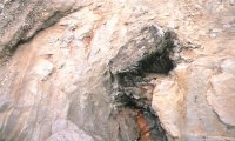
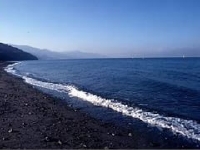 The fusouboku is a four million year old tree which is preserved as a fossil at this site in Iyo City. It is a tree from the metasequoia family , the tree which is the symbol of the city. These fossilized remains of a fusouboku were designated as a Prefectural Designated Natural Object as early as 1956.
The fusouboku is a four million year old tree which is preserved as a fossil at this site in Iyo City. It is a tree from the metasequoia family , the tree which is the symbol of the city. These fossilized remains of a fusouboku were designated as a Prefectural Designated Natural Object as early as 1956.
Kawaragahana Ancient Kiln Site Cluster
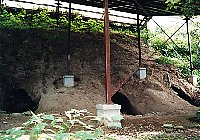 These ancient kiln remains, dating back to the eighth century, are Prefecture Designated Cultural Properties. It is rare for such old kilns to be so intact. These kilns were primarily used for firing tiles, but examples of Sue and Haji were have also been excavated.
These ancient kiln remains, dating back to the eighth century, are Prefecture Designated Cultural Properties. It is rare for such old kilns to be so intact. These kilns were primarily used for firing tiles, but examples of Sue and Haji were have also been excavated.
Mount Tagami Viewing Platform
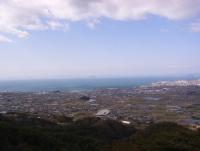
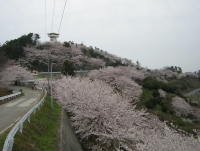 Mount Tagami makes an excellent trip for its views of Iyo City, and the Seto Island Sea and its islands. It is an attractive spot during any one of the four seasons but is particularly notes as a location for cherry blossom viewing. Mount Tagami was named as one of the top 100 natural spots on Shikoku in 1986. It is in the Saragamine Mountain Range Prefectural National Park.
Mount Tagami makes an excellent trip for its views of Iyo City, and the Seto Island Sea and its islands. It is an attractive spot during any one of the four seasons but is particularly notes as a location for cherry blossom viewing. Mount Tagami was named as one of the top 100 natural spots on Shikoku in 1986. It is in the Saragamine Mountain Range Prefectural National Park.
Masaoka Shiki Stone Memorial Tablet
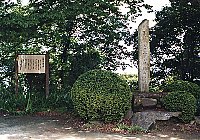
Crossing two Summer rivers - Mount Tagami (Shiki)
A stone tablet on the side of Mount Tagami commemorates a visit to this area by Masaoka Shiki, the creater of modern haiku poetry. On the tablet is written one of Shiki's haikus commemorating his visit:
As is explained on the plaque, Shiki was visiting a friend when he came to Iyo City.
The two rivers mentioned in the above haiku are thought to be the Ishite and Shigenobu rivers, although it is also possible that they are the Uchikawa and Yoshiki rivers.
Fukudenji Temple
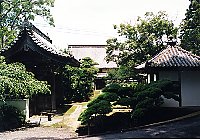 This is a Zen Rinzai Temple and was moved here from Kamiagawa City in 1667. The hermitage and Taishi Hall celebrate the life of Shoutoku Taishi, an imperial prince who helped spread Buddhism in Japan. The gravel garden nest to these buildings is an imitation of that at the Ryouanji Temple in Kyoto. It contains fifteen stones, but from whichever direction you observe the garden it is only possible to see fourteen at one time.
This is a Zen Rinzai Temple and was moved here from Kamiagawa City in 1667. The hermitage and Taishi Hall celebrate the life of Shoutoku Taishi, an imperial prince who helped spread Buddhism in Japan. The gravel garden nest to these buildings is an imitation of that at the Ryouanji Temple in Kyoto. It contains fifteen stones, but from whichever direction you observe the garden it is only possible to see fourteen at one time.
Shirotaki Castle Remains
This castle has a long history dating back to the Kamakura Period. It was originally the castle of a samurai retainer but during the sixteenth century came into the hands of a lord. Today, three walls and three moats still remain.
Mount Toishi
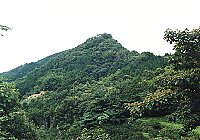 In the mid-nineteenth century a vein of whetstone was discovered on this mountain at which point the village headman donated it to the Oozu clan, the dominant clan in Iyo province (modern day Ehime Prefecture) at that time. The stone mined from this mountain was used for sharpening swords. In feudal times the sword sharpening process involved seven types of stone and Iyo whetstone was used in the middle part of this process.
In the mid-nineteenth century a vein of whetstone was discovered on this mountain at which point the village headman donated it to the Oozu clan, the dominant clan in Iyo province (modern day Ehime Prefecture) at that time. The stone mined from this mountain was used for sharpening swords. In feudal times the sword sharpening process involved seven types of stone and Iyo whetstone was used in the middle part of this process.
Grave of Hata no Saemon
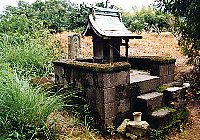 Hata no Saemon was a hunter and farmer in the seventeenth century and is the focus of many old legends of the city. He is reputed to have, among other things, gotten rid of the baboons on Oozu's Mount Kannan and shot the tongue of a crane which had its mouth open.
Hata no Saemon was a hunter and farmer in the seventeenth century and is the focus of many old legends of the city. He is reputed to have, among other things, gotten rid of the baboons on Oozu's Mount Kannan and shot the tongue of a crane which had its mouth open.
Mizunomyou Shrine
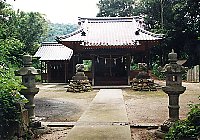 This shrine was the focal point of prayers for rain by forty different villages during feudal times. Prayers were on occasion led by samurai loads and involved villagers beating drums and raising their voices in prayer.
This shrine was the focal point of prayers for rain by forty different villages during feudal times. Prayers were on occasion led by samurai loads and involved villagers beating drums and raising their voices in prayer.
Local Speciality Food Center
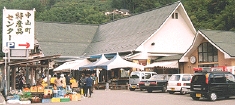 This speciality food shop is conveniently located beside JR Nakayama train station and sells a wide range of delicious local foods including soba noodles and many different types of chestnuts. There is also a restaurant which serves locally-produced noodles.
This speciality food shop is conveniently located beside JR Nakayama train station and sells a wide range of delicious local foods including soba noodles and many different types of chestnuts. There is also a restaurant which serves locally-produced noodles.
Wood Craft Centre
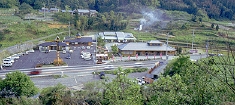 Here you are able to buy various wooden products specially made in Nakayama.
Here you are able to buy various wooden products specially made in Nakayama.
The Home of Crafts
At the home of crafts you can attempt to make the local product, the chestnut, at this local attraction. Try some local cuisine at the Irori-an Restaurant before looking at the community photograph gallery. Finish your visit by buying some food made with the high-quality local chestnuts.
Futami Seaside Park
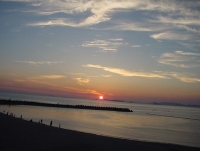 This is an extremely popular place, especially in the summer when it is filled with people participating in beach volleyball tournaments, sightseers observing the sight of the beautiful setting sun and others enjoying the views across the Inland Sea. It is a great spot to go swimming and cool down in the summer, and has a second beach next door which can be used for camping and barbecues.
This is an extremely popular place, especially in the summer when it is filled with people participating in beach volleyball tournaments, sightseers observing the sight of the beautiful setting sun and others enjoying the views across the Inland Sea. It is a great spot to go swimming and cool down in the summer, and has a second beach next door which can be used for camping and barbecues.
Shiokaze Fureai no Yakata
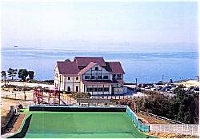 The facilities here, which include sports fields, tennis courts, an artificial grass ski slope, children's play park and viewing platform, are in an ideal location on a mountainside overlooking the sea. There is also a campsite and facilities which can be used for conference and educational camps.
The facilities here, which include sports fields, tennis courts, an artificial grass ski slope, children's play park and viewing platform, are in an ideal location on a mountainside overlooking the sea. There is also a campsite and facilities which can be used for conference and educational camps.
JR Shimonada Train Station
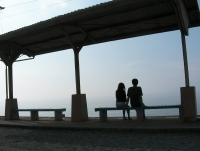 Just down the coast from Futami Seaside Park is one of the train station in Japan closest to the sea. This train platform regularly features in national publicity campaigns promoting Japan Railway ticket offers. This location is also the site of the annual Sunset Platform Concert.
Just down the coast from Futami Seaside Park is one of the train station in Japan closest to the sea. This train platform regularly features in national publicity campaigns promoting Japan Railway ticket offers. This location is also the site of the annual Sunset Platform Concert.
お問い合わせ
より良いウェブサイトにするためにみなさまのご意見をお聞かせください


